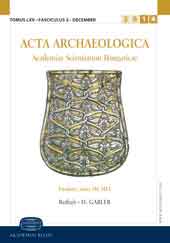Mining data from Roman sandstone quarries
Mining data from Roman sandstone quarries
Author(s): Sylvia K. Palágyi, O. Csirke, J. FUTÓ, J. HLAVAY, B. RAUCSIK, A. Szabó, I. VASSÁNYISubject(s): Archaeology, Cultural history, Ancient World, Evaluation research
Published by: Akadémiai Kiadó
Keywords: Roman sandstone; Archeological research; Data Mining; Roman carvings;
Summary/Abstract: This paper presents some of the archaeological results of the research project No. IKTA-00142/2002. The project aimed at disseminating the methods and tools of Data Mining among the researchers of various sciences (medical science, archaeology and seismology). Traditionally developed for market and customer behavior analysis in financial applications, Data Mining provides a set of configurable methods to discover useful knowledge hidden in data. Based on a combination of traditional statistical and artificial intelligence algorithms, the methods of data mining include classification (supervised learning), association discovery, grouping (unsupervised learning), time series analysis and others. In order for these methods to run, however, available data must be first collected, organized and stored in electronic form, then it must be “cleaned”, that is, checked and amended for consistency and validity. These steps usually consume as much as 80% of a data mining project’s budget and run time, before the actual data analysis can begin. The sandstone analysis described in this paper was no exception, partly due to the complex process of chemical composition analysis.
Journal: Acta Archaeologica Academiae Scientiarum Hungaricae
- Issue Year: 57/2006
- Issue No: 4
- Page Range: 395-422
- Page Count: 28
- Language: English
- Content File-PDF

